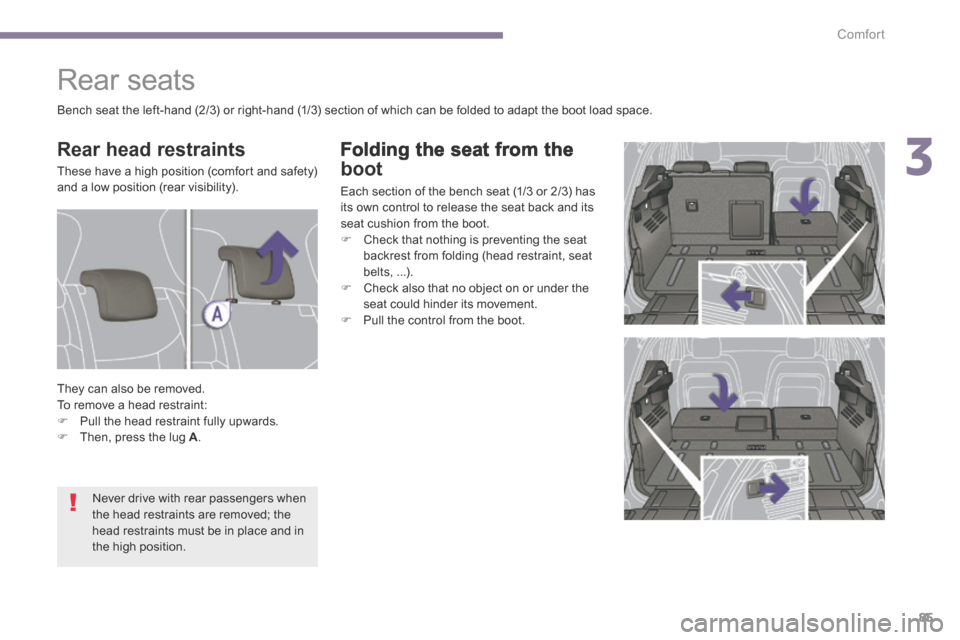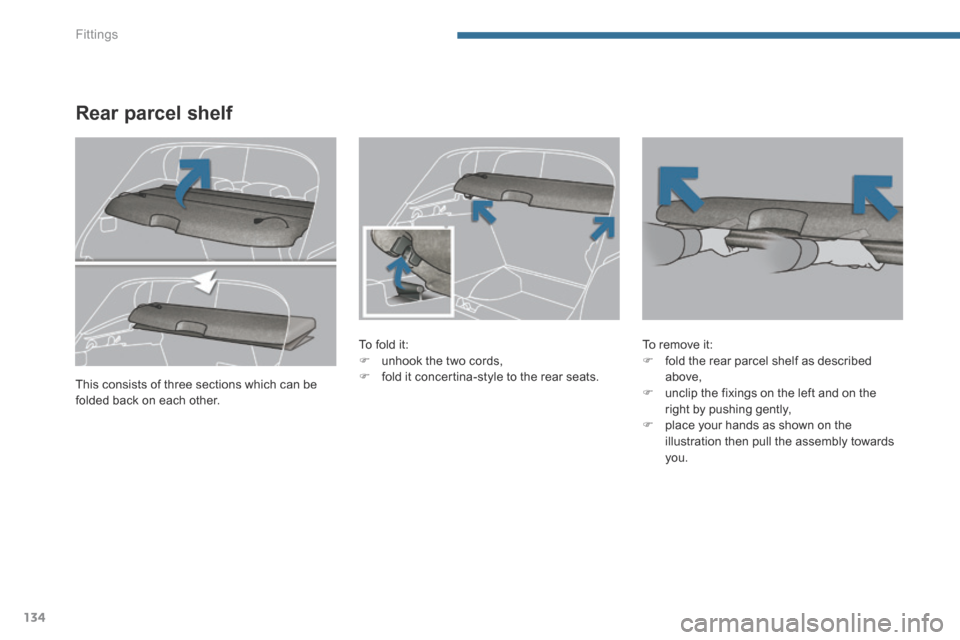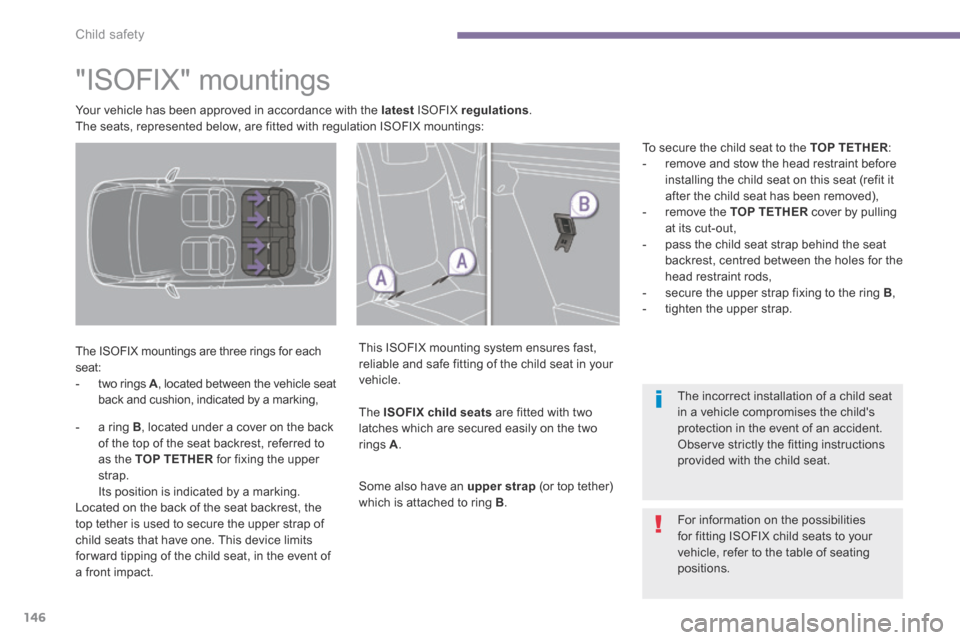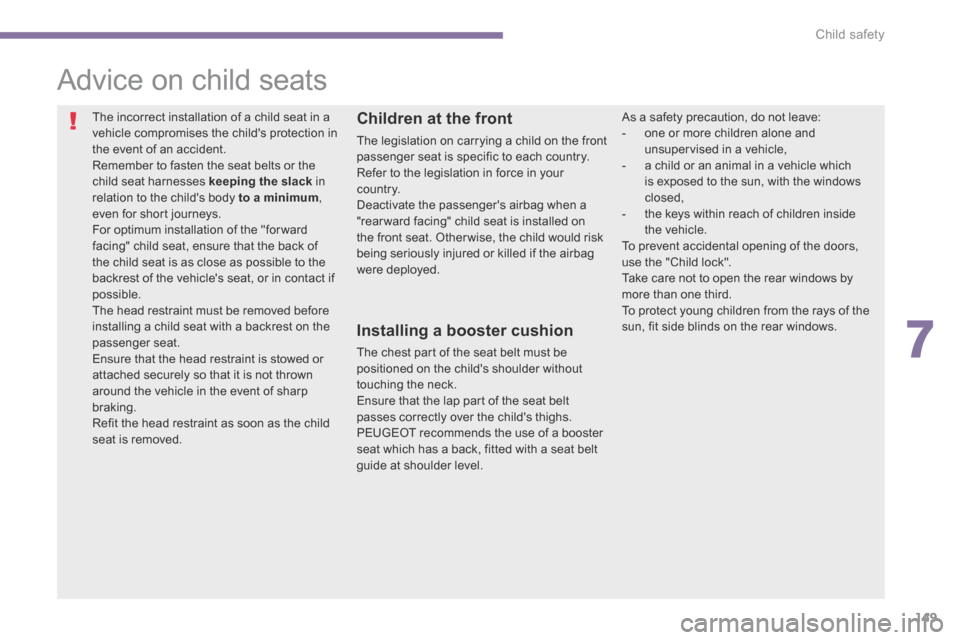2014 Peugeot 3008 Hybrid 4 remove seats
[x] Cancel search: remove seatsPage 43 of 378

.Hybrid system41
Limit the causes of excess
consumption
Spread loads throughout the vehicle; place the heaviest items in the bottom of the boot, as close as possible to the rear seats. Limit the loads carried in the vehicle and reduce wind resistance (roof bars, roof rack, bicycle carrier, trailer...). Use a roof box in preference. Remove roof bars and roof racks after use.
At the end of winter, remove snow tyres and refit your summer tyres.
Observe the recommendations
on maintenance
Check the tyre pressures regularly, when cold, referring to the label in the door aperture, driver's side. Carry out this check in particular: - before a long journey, - at each change of season, - after a long period out of use. At the wheel of your new vehicle, it is only after the first 1 800 miles (3 000 kilometres) that you will see the fuel consumption settle down to a consistent average.
Have your vehicle serviced regularly (engine oil, oil filter, air filter...) and observe the schedule of operations recommended by the manufacturer.
When refuelling, do not continue after the 3 rd cut-off of the nozzle to avoid any over flow.
Page 87 of 378

3
Comfort85
Folding the seat from the
boot
Each section of the bench seat (1/3 or 2/3) has its own control to release the seat back and its seat cushion from the boot. Check that nothing is preventing the seat backrest from folding (head restraint, seat belts, ...). Check also that no object on or under the seat could hinder its movement. Pull the control from the boot.
Rear seats
Rear head restraints
They can also be removed. To remove a head restraint: Pull the head restraint fully upwards. Then, press the lug A .
Bench seat the left-hand (2/3) or right-hand (1/3) section of which can be folded to adapt the boot load space.
These have a high position (comfort and safety) and a low position (rear visibility).
Never drive with rear passengers when the head restraints are removed; the head restraints must be in place and in the high position.
Page 136 of 378

Fittings
134
Rear parcel shelf
To fold it: unhook the two cords, fold it concertina-style to the rear seats.
To remove it: fold the rear parcel shelf as described above, unclip the fixings on the left and on the right by pushing gently, place your hands as shown on the illustration then pull the assembly towards you.
This consists of three sections which can be folded back on each other.
Page 148 of 378

Child safety
146
"ISOFIX" mountings
The ISOFIX mountings are three rings for each seat: - two rings A , located between the vehicle seat back and cushion, indicated by a marking,
This ISOFIX mounting system ensures fast, reliable and safe fitting of the child seat in your vehicle.
The ISOFIX child seats are fitted with two latches which are secured easily on the two rings A .
Some also have an upper strap (or top tether) which is attached to ring B .
To secure the child seat to the TOP TETHER : - remove and stow the head restraint before installing the child seat on this seat (refit it after the child seat has been removed), - remove the TOP TETHER cover by pulling
at its cut-out, - pass the child seat strap behind the seat backrest, centred between the holes for the head restraint rods, - secure the upper strap fixing to the ring B , - tighten the upper strap.
Your vehicle has been approved in accordance with the latest ISOFIX regulations . The seats, represented below, are fitted with regulation ISOFIX mountings:
- a ring B , located under a cover on the back of the top of the seat backrest, referred to as the TOP TETHER for fixing the upper strap. Its position is indicated by a marking. Located on the back of the seat backrest, the top tether is used to secure the upper strap of child seats that have one. This device limits for ward tipping of the child seat, in the event of a front impact.
For information on the possibilities for fitting ISOFIX child seats to your vehicle, refer to the table of seating positions.
The incorrect installation of a child seat in a vehicle compromises the child's protection in the event of an accident. Observe strictly the fitting instructions provided with the child seat.
Page 151 of 378

7
Child safety149
Advice on child seats
The incorrect installation of a child seat in a vehicle compromises the child's protection in the event of an accident. Remember to fasten the seat belts or the child seat harnesses keeping the slack in relation to the child's body to a minimum , even for short journeys. For optimum installation of the "forward facing" child seat, ensure that the back of the child seat is as close as possible to the backrest of the vehicle's seat, or in contact if possible . The head restraint must be removed before installing a child seat with a backrest on the passenger seat. Ensure that the head restraint is stowed or attached securely so that it is not thrown around the vehicle in the event of sharp braking. Refit the head restraint as soon as the child seat is removed.
Children at the front
The legislation on carrying a child on the front passenger seat is specific to each country. Refer to the legislation in force in your c o unt r y. Deactivate the passenger's airbag when a "rear ward facing" child seat is installed on the front seat. Otherwise, the child would risk being seriously injured or killed if the airbag were deployed.
Installing a booster cushion
The chest part of the seat belt must be positioned on the child's shoulder without touching the neck. Ensure that the lap part of the seat belt passes correctly over the child's thighs. PEUGEOT recommends the use of a booster seat which has a back, fitted with a seat belt guide at shoulder level.
As a safety precaution, do not leave: - one or more children alone and unsupervised in a vehicle, - a child or an animal in a vehicle which is exposed to the sun, with the windows closed, - the keys within reach of children inside the vehicle. To prevent accidental opening of the doors, use the "Child lock". Take care not to open the rear windows by more than one third. To protect young children from the rays of the sun, fit side blinds on the rear windows.
Page 165 of 378

8
Safety163
For the airbags to be fully effective, observe the following safety rules:
Sit in a normal upright position. Wear a correctly adjusted seat belt. Do not leave anything between the occupants and the airbags (a child, pet, object...). This could hamper the operation of the airbags or injure the occupants. After an accident or if the vehicle has been stolen or broken into, have the airbag systems checked. All work on the airbag system must be carried out by a PEUGEOT dealer or a qualified workshop. Even if all of the precautions mentioned are observed, a risk of injury or of minor burns to the head, chest or arms when an airbag is deployed cannot be ruled out. The bag inflates almost instantly (within a few milliseconds) then deflates within the same time discharging the hot gas via openings provided for this purpose.
Lateral airbags
Use only approved covers on the seats, compatible with the deployment the lateral airbags. For information on the range of seat covers suitable for your vehicle, you can contact a PEUGEOT dealer. Refer to the "Accessories" section. Do not fix or attach anything to the seat backs (clothing...). This could cause injury to the chest or arms if the lateral airbag is deployed. Do not sit with the upper part of the body any nearer to the door than necessary.
Front airbags
Do not drive holding the steering wheel by its spokes or resting your hands on the centre part of the wheel. Passengers must not place their feet on the dashboard. If possible, do not smoke as deployment of the airbags can cause burns or the risk of injury from a cigarette or pipe. Never remove or pierce the steering wheel or hit it violently.
Curtain airbags
Do not fix or attach anything to the roof. This could cause injury to the head if the curtain airbag is deployed. If fitted on your vehicle, do not remove the grab handles installed on the roof, they play a part in securing the curtain airbags.